92nd Infantry Division (United States)
| 92nd Division 92nd Infantry Division (Colored) | |
|---|---|
|
Shoulder sleeve insignia | |
| Active |
1917–1919 1942–1945 |
| Country |
|
| Branch |
|
| Type | Infantry |
| Size | Division |
| Nickname(s) | "Buffalo Soldiers" |
| Motto(s) | "Deeds, not Words |
| Engagements | |
| Commanders | |
| Notable commanders | Maj. Gen. Edward M. Almond |
| Insignia | |
| Distinctive unit insignia |
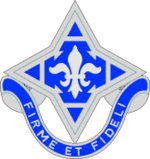 |
The 92nd Infantry Division was an infantry division of the United States Army that served in both World War I and World War II. Organized in October 1917 at Camp Funston, Kansas, the unit was formed with African American soldiers from all states. Before leaving for France in 1918, the buffalo was selected as the divisional insignia due to the "Buffalo Soldiers" nickname, given to African American cavalrymen by Native Americans in the 19th century. The "Buffalo Soldiers Division" divisional nickname was inherited from the 367th Infantry, one of the first units of the division organized. This segregated unit was the only African American infantry division to see combat in Europe during World War II, as part of the U.S. Fifth Army, fighting in the Italian Campaign.[1] It served in the Italian Campaign from 1944 to the war's end.
History
The 92nd Division was first constituted on paper 24 October 1917 in the National Army, over six months after the American entry into World War I.[2] The division was commanded throughout most of its existence by Major General Charles C. Ballou and was composed of the 183rd Infantry Brigade with the 365th and 366th Infantry Regiments, and the 184th Infantry Brigade with the 367th and 368th Infantry Regiments, together with supporting artillery, engineer, medical and signal units attached.[3] The division was actually organized on 27 October 1917 at Camp Funston, Kansas.[2]
World War I
- Activated: October 1917
- Overseas: 18 July 1918
- Major operations: Meuse-Argonne less field artillery
- Casualties: total: 1,647 (KIA: 120; WIA: 1,527).
- Commanders: Maj. Gen. Charles C. Ballou (29 October 1917), Maj. Gen. Charles Henry Martin (19 November 1918), Brig. Gen. James B. Erwin (16 December 1918).
- Returned to United States and inactivated: February 1919.
For an account of the fighting of the Buffalo Division in the Woevre Plain offensive see the article on William M Cain at Kaiserscross.com.
As would be the case with the 93rd Division, parts of the 92nd would serve under and alongside the French Army after both the main American Expeditionary Force (AEF) and the British Expeditionary Force (BEF) refused to have African-American soldiers serve in combat under them.
The 92nd was a National Army unit formed from black draftees, with a cadre of 154 NCOs transferred from the four Regular Army regiments, mostly led by inexperienced black junior officers fresh out of training and commanded by indifferent white officers. They were a green and untried unit that was not allowed to maneuver as a division before they were committed to the line. After arrival on the Western Front, the 92nd, like all AEF units, trained for deployment in the trenches. They began to be fed into the French sector front lines by company in mid-August 1918. The 92nd Artillery Brigade only came online in October 1918.
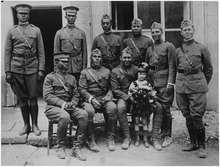
Unlike the 93rd, the 92nd would ultimately fight as a whole under American command. The division saw combat in the Meuse-Argonne Offensive during November 1918. Their indifferent showing was more due to brittle morale and poor handling by their white superiors than any real failings.
Units
92nd Division (1917–19)
- 92nd Division Headquarters Troop
- Support units
- 317th Engineer Regiment
- 317th Signals Battalion
- 349th MG Battalion
- 183rd Brigade (Infantry)
- 365th Infantry Regiment
- 366th Infantry Regiment
- 350th MG Battalion
- 184rd Brigade (Infantry)
- 367th Infantry Regiment
- 368th Infantry Regiment
- 351st MG Battalion
- 167th Brigade (Field Artillery)
- 349th Field Artillery Regiment
- 350th Field Artillery Regiment
- 351st Field Artillery Regiment
- 317th Trench Mortar Battery
World War II
- Activated: 15 October 1942.
- Overseas: 22 September 1944.
- Campaigns: North Apennines, Po Valley.
- Awards: Medal of Honor: 2 (Posthumously in 1997); Distinguished Service Cross (United States): 2; Distinguished Service Medal (United States): 1; Silver Star: 208; Legion of Merit: 16; Soldier's Medal: 6; Bronze Star: 1,166; Purple Heart: 1,891; Order of the Crown of Italy: 8; Military Cross for Military Valor (Italian): 17; Military Cross for Merit in War (Italian): 22; War Medal (Brazil): 1
- Commanders: Maj. Gen. Edward Almond (October 1942 – August 1945), Brig. Gen. John E. Wood (August 1945 to inactivation).
- Returned to the United States: 26 November 1945.
- Inactivated: 28 November 1945.
The division was reactivated as an infantry division on 15 October 1942 at Fort Huachuca, Arizona and spent almost two years training in the United States. In late July 1944, the 370th Infantry Regiment was sent overseas to Italy and temporarily attached to the 1st Armored Division. The rest of the division would be sent overseas in September of that year, and the division as a whole would see heavy combat during the remainder of the Italian Campaign.
During the division's participation in the Italian Front, the Buffalo Soldiers made contact with units of many nationalities: beyond the attached 442nd RCT, they also had contact with the segregated troops of the British and French colonial empires (Black Africans, Moroccans, Algerians, Indians, Gurkhas, Arab and Jewish Palestinians) as well as with exiled Poles, Greeks and Czechs, anti-fascist Italians and the nonsegregated troops of the Brazilian Expeditionary Force (FEB).[4][5][6]
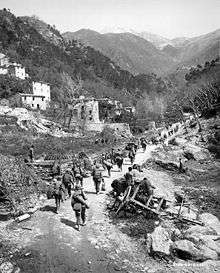
The division's magazine was The Buffalo.[7] Its art director, Ted Shearer, would go on to create the early African-American comic strip Quincy.[8]
Commanders
The division's commander, Major General Edward Almond, was for a time highly regarded by General George Marshal, the Army Chief of Staff, who was a fellow Virginia Military Institute (VMI) graduate. This was a major factor in Almond's promotion to major general and subsequent command of the division, a position he held from its formation in October 1942 until August 1945. He led the division in combat throughout the Italian Campaign of 1944–1945. Almond was chosen by Marshall to command the division because Marshall believed Almond would excel at what was seen as a difficult assignment. However, Almond performed poorly and went on to blame his poor performance on the fact that the division was made up of largely African American troops. He saw his troops as the source of his failure in combat, and went on to advise the army against ever again using African Americans as combat troops.[9]
_Division_in_Italy%2C_inspects_his_troops_during_a_decoration_ceremony.jpg)
According to Colonel Howard Donovan Queen: "Whatever shortcomings the 92nd had, it rested entirely on the shoulders of Major General Almond. His entire staff was incompetent, excepting for Brigadier General (William H.) Coburn, the artillery commander, whose artillery was rated among the best on the front."[10]
Gothic Line
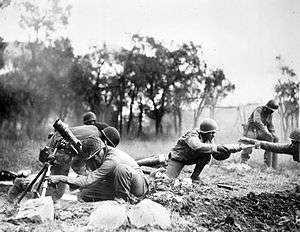
The 370th Regimental Combat Team, attached to the 1st Armored Division, arrived in Naples, Italy, 1 August 1944 and entered combat on 24th. It participated in the crossing of the Arno River, the occupation of Lucca and the penetration of the Gothic Line. Enemy resistance was negligible in its area. As Task Force 92, elements of the 92nd attacked on the Ligurian coastal flank toward Massa, 5 October. By the 12th, the slight gains achieved were lost to counterattacks. On 13 October, the remainder of the Division concentrated for patrol activities. Elements of the 92nd moved to the Serchio sector, 3 November 1944, and advanced in the Serchio River Valley against light resistance, but the attempt to capture Castelnuovo di Garfagnana did not succeed. Patrol activities continued until 26 December when the enemy attacked, forcing units of the 92nd to withdraw. According to David Irving's book The War Between the Generals,[11] the 92nd had "turned and run, clear proof in the army's view that black troops were unreliable unless led by white officers and NCOs". The attack ended on 28 December. The attacking forces were mainly from the Republic of Salò's Fascist Army, the 4th "Monte Rosa" Alpine Division (four battalions), with the support of three German battalions. Aside from patrols and reconnaissance, units of the 92nd attacked enemy forces in the Serchio sector from 5–8 February 1945, advancing against the 1st "Italia" Bersaglieri Division, but enemy counterattacks nullified all Division advances.
1945
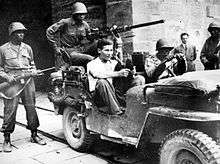
On 1 April, the 370th RCT and the attached 442nd Regimental Combat Team (Nisei) attacked the Ligurian coastal sector and drove rapidly north against light opposition from the German 148th Infantry Division, which was supported only by Italian coastal units. The 370th took over the Serchio sector and pursued the retreating enemy from 18 April until the collapse of all enemy forces on 29 April 1945. Elements of the 92nd Division entered La Spezia and Genoa on 27th and took over selected towns along the Ligurian coast until the enemy surrendered on 2 May 1945.
Casualties
- Total battle casualties: 2,997[12]
- Killed in action: 548[13]
- Wounded in action: 2,187[14]
- Missing in action: 206[15]
- Prisoner of war: 56[16]
Medal of Honor recipients
- John R. Fox, 1st Lt, Cannon Company, 366th Infantry Regiment, 92nd Infantry Division, near Sommocolonia, Serchio Valley, Italy, 26 December 1944.
- Vernon J. Baker, 1st Lt, 92nd Infantry Division, near Viareggio, Italy, 5–6 April 1945.
Note: The MOH was not awarded to these recipients until 1997.
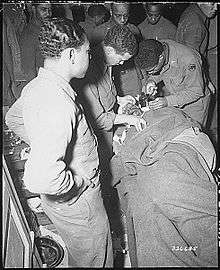
Units
92nd Division (1942–45)
- 365th Infantry Regiment
- 370th Infantry Regiment
- 371st Infantry Regiment
- 597th Field Artillery Battalion (105mm)
- 598th Field Artillery Battalion (105mm)
- 599th Field Artillery Battalion (105mm)
Support units:
- 92nd Military Police Platoon
- 92nd Quartermaster Company
- 92nd Signal Company
- 92nd Cavalry Reconnaissance Troop (Mechanized)
- 792nd Ordnance (Light Maintenance) Company
- 317th Engineer Battalion
- 317th Medical Battalion
- 600th Field Artillery Battalion (155mm)
Attached units:
- 366th Infantry Regiment (Nov, 1944 – Feb, 1945)
- 442nd Infantry Regiment (Nisei) (April 1945 – )
- 473rd Regimental Combat Team (formed from anti-aircraft units) (February 1945 – May 1945?).
- 758th Tank Battalion (Colored)
- 679th Tank Destroyer Battalion (Colored)
- 894th Tank Destroyer Battalion
- 701st Tank Destroyer Battalion
Task Force 1 (February 1945):
- 3rd Battalion / 366th Infantry Regiment
- Company B, 317th Engineer Battalion
- 760th Tank Battalion
- 84th Chemical Mortar Battalion (4.2" [107mm])
- 27th Armored Field Artillery Battalion
See also
Notes
- ↑ Video: U.S. Air ForAllied Bombers Strike On Two Fronts Etc (1945). Universal Newsreel. 1945. Retrieved February 21, 2012.
- 1 2 Wilson, p. 545.
- ↑ McGrath, p. 173 – 174.
- ↑ Ready, J.Lee, Forgotten Allies: The Military Contribution of the Colonies, Exiled Governments and Lesser Powers to the Allied Victory in World War II
- ↑ Motley, 1975. Pages 259-61, 274 and 288.
- ↑ Ready, J.Lee, Forgotten Allies: The European Theatre, Volume I
- ↑ Hodges, Robert Jr. (June 12, 2006). "African American 92nd Infantry Division Fought in Italy During World War II". World War II magazine (World History Group, pub.) via Historynet.com. Archived from the original on 13 January 2015. Retrieved March 23, 2015.
- ↑ Otfinoski, Steven (2011). African Americans in the Visual Arts. Facts on File Library of American History. p. 184. ISBN 978-0816078400.
- ↑ Ricks, Thomaz E. "The Generals: American Military Command from World War II to Today" Penguin Press, 2012 ISBN 9781594204043 pages 152-53
- ↑ Motley, 1975. Page 259
- ↑ Irving, David (January 1, 1981). The War Between the Generals: Inside the Allied High Command. Congdon & Lattes. ISBN 978-0312929206.
- ↑ Army Battle Casualties and Nonbattle Deaths, Final Report (Statistical and Accounting Branch, Office of the Adjutant General, 1 June 1953)
- ↑ Army Battle Casualties and Nonbattle Deaths, Final Report (Statistical and Accounting Branch, Office of the Adjutant General, 1 June 1953)
- ↑ Army Battle Casualties and Nonbattle Deaths, Final Report (Statistical and Accounting Branch, Office of the Adjutant General, 1 June 1953)
- ↑ Army Battle Casualties and Nonbattle Deaths, Final Report (Statistical and Accounting Branch, Office of the Adjutant General, 1 June 1953)
- ↑ Army Battle Casualties and Nonbattle Deaths, Final Report (Statistical and Accounting Branch, Office of the Adjutant General, 1 June 1953)
References
- Combat Chronicles of U.S. Army Divisions in World War II. U.S. Government Printing Office. Retrieved 9 July 2010.
- Daugherty, James Harden (2009). The Buffalo Saga: a story from World War II U.S. Army 92nd Infantry Division known as the Buffalo Soldiers. Xlibris Corp. ISBN 1-4363-9654-9.
- Gibran, Daniel K. (2001). The 92nd Infantry Division and the Italian Campaign in World War II. McFarland & Company. ISBN 0-7864-1009-4.
- Gibson, Jr., Truman K. (2005). Knocking Down Barriers: My Fight for Black America. Northwestern University Press. ISBN 0-8101-2292-8.
- Hargrove, Hondon B. (1985). Buffalo Soldiers in Italy: Black Americans in World War II. McFarland & Company. ISBN 0-89950-116-8.
- McGrath, John J. (2004). The Brigade: A History: Its Organization and Employment in the US Army. Combat Studies Institute Press. ISBN 978-1-4404-4915-4.
- Motley, Mary Penick. (1975) The Invisible Soldier: The Experience of the Black Soldier, World War II. Wayne State University Press ISBN 0814319610
- Ready, J. Lee (1985). Forgotten Allies: The Military Contribution of the Colonies, Exiled Governments and Lesser Powers to the Allied Victory in World War II. Volume I: The European Theatre. McFarland & Company. ISBN 978-0-89950-117-8.
- Wilson, John B. (1999). Armies, Corps, Divisions, and Separate Brigades. United States Army Center of Military History. ASIN B000OJKX1S.
External links
| Wikimedia Commons has media related to 92nd Infantry Division (United States). |
- Division History 92d Infantry
- Vernon Baker (MOH recipient)
- John R. Fox (MOH recipient)
- The Buffalo Soldiers of World War II, a memoir based on journal kept by Ivan J. Houston, a Buffalo Soldier
- A Path to Lunch Liberation Day and the Liberation of America, The 92nd in Lunigiana and Versilia.

_troops_return_colors_to_Union_League_Club._Men_draw_._._._-_NARA_-_533590.tif.jpg)